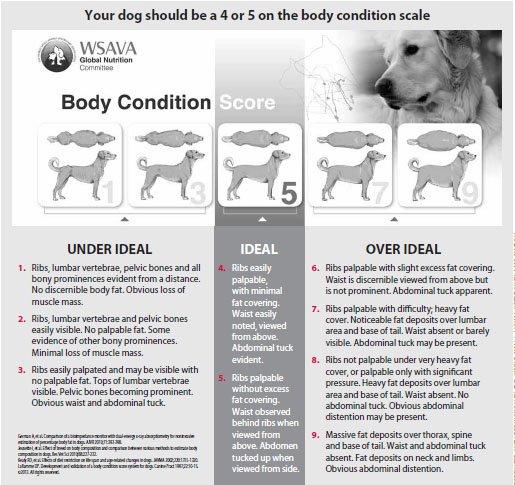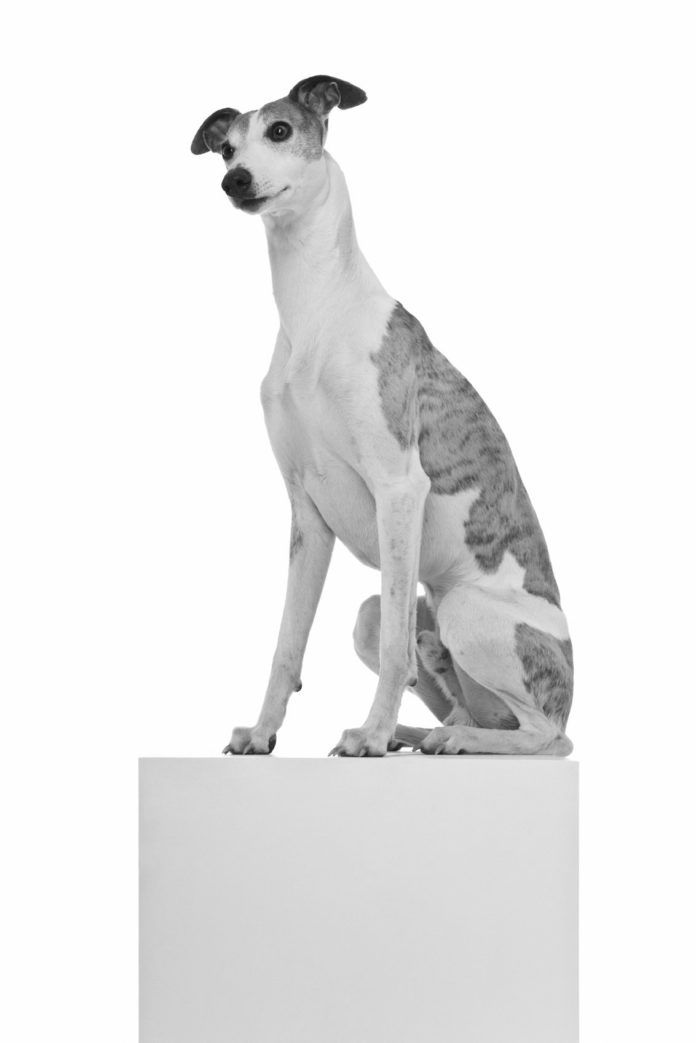“I once talked to an owner of a standard poodle who wanted to find out what was wrong with her dog since he just wasn’t that interested in food. The woman believed he was ‘too thin,'” says Tufts veterinary nutritionist Lisa Freeman, DVM, PhD, DACVN. “But his laboratory tests were all normal, and upon doing a physical exam, it was clear that the dog was a 4 out of 9 on the body condition scale and also had normal muscle condition — perfectly fit and healthy, as dogs of ideal weight range from a 4 to a 5. It turned out the woman used to have a Labrador retriever who loved to eat, so it was a big change for her to have a dog who was relatively uninterested in food.”
The woman was not alone in her thinking. Many owners have a distorted image of what ideal body condition looks like. “My own dog is a 4 out of 9, and people frequently comment that she is too thin,” Dr. Freeman says. “Body perception is not always accurate. It’s not uncommon for an owner to bring in a dog to see me because of anxiety that their dog is too skinny, and it turns out it’s not. There are cases where dogs are too thin. But otherwise healthy dogs are usually not.
Recognizing A Truly Underweight Dog
One reason people may perceive perfectly healthy dogs to be underweight when they aren’t is that the nation’s dogs have been experiencing an obesity crisis paralleling that of their owners, causing “too heavy” to become the new normal and ideal weight to become “too thin.” So many dogs are now overweight that it doesn’t stand out as much anymore. What stands out are dogs on the thin side.
Dogs that tend to stay trim easily, says Dr. Freeman, are the high-energy breeds: standard poodles, German short-haired pointers, and so on. Certain other breeds, by contrast, tend to veer toward becoming overweight, with dogs such as Labrador retrievers and beagles often ending up at a higher number than the ideal 4 or 5 on the 9-point body condition scale. The irony is that such overweight dogs are common enough that their owners may overlook the problem. The naturally trim breeds, on the other hand, are often among the ones that people bring to the doctor in the erroneous belief that the dog doesn’t have enough heft to be healthy. We had one woman write in that her standard poodle was too thin, but she pointed out in the same letter that he was in good health and was very active, jogging and hiking with her. A dog who is too thin due to an actual health problem would probably have a hard time jogging and hiking and wouldn’t be ingood health.
Also throwing some people off is the erroneous notion that all dogs will enthusiastically eat as much food as their owners give them. Many dogs go crazy over food, but many others live lives that don’t revolve around the next morsel that their owner might be willing to let drop to the floor.
That said, the only way you can know for sure whether your dog is too thin is to take him to his veterinarian, or perhaps a board-certified veterinary nutritionist. The doctor will check his body condition score — an overall assessment of his fat stores — by looking at his body from both above and from the side and also by palpating (feeling) certain areas of his trunk. With an ideal score of 4 or 5 (see the Body Condition Score chart on the opposite page that was put out by the World Small Animal Veterinary Association), the ribs will be easily felt from the outside, and the waist will clearly be tucked when viewed from above. Moreover, the abdomen will be tucked up when viewed from the side. That is, lean is not too thin.
Only if the ribs are visible with no palpable fat is the dog too thin. In particularly severe cases, the ribs, lower back vertebrae, and pelvic bones may be easily visible, with little to no discernible body fat. In those instances, the dog will look like it’s literally starving, because it is.
Along with checking the dog for his overall body condition score, the vet should check his muscle condition score. Muscle loss occurs during aging but also as the result of certain diseases, such as heart disease, kidney disease, infection, cancer, or other medical problems. If there’s evidence of muscle wasting, Dr. Freeman says, “it becomes more worrisome that there’s an underlying issue that needs to be thoroughly investigated. The underlying medical issue can cause poor utilization of calories or other problems that can interfere with the dog’s optimal nutrition status.
The hitch is that finding an underlying reason for a dog’s excessive thinness is not always easy, and may require lots of testing. “It could be 1,001 things,” Dr. Freeman says. Maybe dental disease is making it too hard for your dog to eat comfortably. He may have a tooth or gum condition that makes chewing painful. Kidney disease, too, can alter a dog’s appetite, perhaps by making him feel nauseated or by changing his food preferences. Intestinal diseases may also interfere with the desire to eat or the ability to absorb nutrients, and certain cancers can get in the way of optimal body condition as well. Sometimes it’s a medication the dog is already taking that could be cutting into his appetite or affecting his nutrient absorption. It could even be parasites that are interfering with his eating and weight. Some basic blood work will have to be ordered, and perhaps some imaging in the form of x-rays or an ultrasound. From there, if necessary, more specialized testing may be in order.
Also important once body condition score, muscle condition score, or both show a dog on the too-low side of healthy weight: a complete diet history. The veterinarian has to find out not just how much food you’ve been feeding but also the overall nutritional balance and quality of that food. For example, homemade diets (shown in multiple studies to be nutritionally unbalanced unless formulated by a board-certified veterinary nutritionist) are capable of causing severe excesses or deficiencies of nutrients that might lead to health problems, including weight loss. Dog foods intended for intermittent or supplemental use only also can cause significant problems like underweight. So can a dog food made by a small company without good quality control in place or without a full time board-certified veterinary nutritionist or PhD in nutrition.
Another potential problem: the food you’re serving may just be too low in calories — dog foods can range from just over 200 calories per cup to nearly 600 calories per cup. Sometimes owners may change foods but continue to feed the same volume. If the food is lower in calories per cup, the dog will lose weight.


Reprinted with permission by the World Small Animal Veterinary Association.
These are among the myriad reasons a diet history is so important. Part of that history will also include a look at any supplements the dog has been taking, as one of the serious side effects of supplements can be weight loss. Treats, including table scraps, will be assessed, too. If more than 10 percent of a dog’s overall calories come from treats or table food, the overall diet will be unbalanced and can cause weight loss.
Helping Dogs Maintain Healthy Weight
If the dog is eating a diet that is nutritionally unbalanced or whose calories and other nutrients are not being well assimilated by his body, it is critical to switch him to a well known brand made by a reputable company that has a good history of testing its products to insure a proper balance of nutrients and efficient digestion by the body. This is critical.
But sometimes it’s not the food that’s the problem. Very, very rarely, a misguided owner will be feeding his dog too little of the right food. Perhaps the dog is too active for the guidelines on the package about how much food to give daily, or maybe the owner is giving the amount of food on the low end of the range advised by the company when he needs to give the amount of food at the high end. A veterinarian can go over these points with you.
If the quality or quantity of food is not the issue, testing to identify an underlying medical condition should uncover the reason for a dog’s underweight. From there, steps can be taken both to treat the disease as well as to determine what the optimal food is to help manage that disease and how much to feed. Again, your veterinarian or a board-certified veterinary nutritionist can help you work this out. Bear in mind that a dog of ideal body and muscle condition is going to be in a better position to fight any illness than one who is too thin.
But Dr. Freeman emphasizes that in the vast majority of cases, the young, healthy dogs of people who worry that their pet is too thin are in optimal body condition and optimal muscle condition. Always better to be safe than sorry and bring in your dog for a professional assessment, she says, but if the dog is healthy, and active, “I would bet you dollars to doughnuts that the dog is in perfect shape.”






My male dog is 5 years old and has been skinny from day one. All the pups he has fathered are as skinny as he is. He gets nutritious food and tonic and has a normal eating habit but I can feel his bones. He looks like an over fluffy German shepherd. His fur hides his skinny bony. Is he naturally skinny?